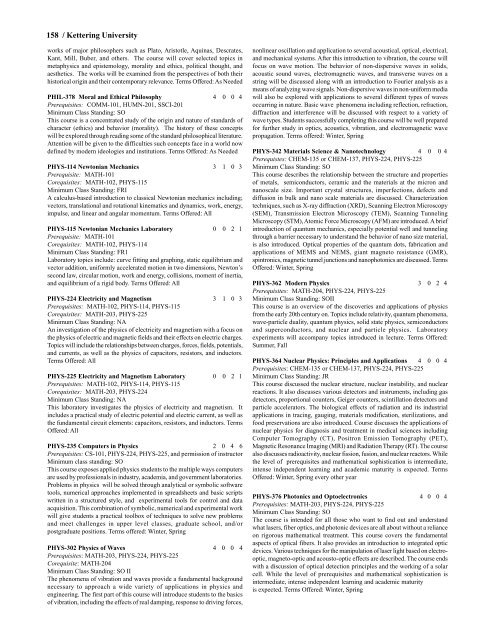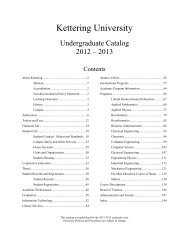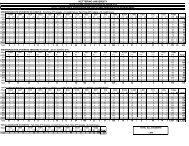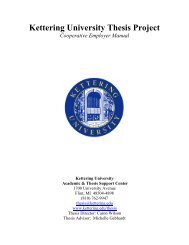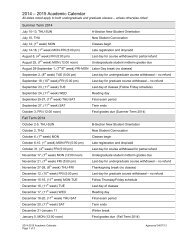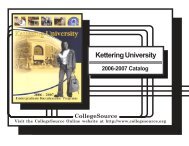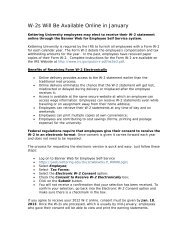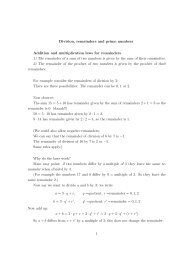2007-2008 Undergraduate Catalog - Kettering University
2007-2008 Undergraduate Catalog - Kettering University
2007-2008 Undergraduate Catalog - Kettering University
You also want an ePaper? Increase the reach of your titles
YUMPU automatically turns print PDFs into web optimized ePapers that Google loves.
158 / <strong>Kettering</strong> <strong>University</strong><br />
works of major philosophers such as Plato, Aristotle, Aquinas, Descrates,<br />
Kant, Mill, Buber, and others. The course will cover selected topics in<br />
metaphysics and epistemology, morality and ethics, political thought, and<br />
aesthetics. The works will be examined from the perspectives of both their<br />
historical origin and their contemporary relevance. Terms Offered: As Needed<br />
PHIL-378 Moral and Ethical Philosophy 4 0 0 4<br />
Prerequisites: COMM-101, HUMN-201, SSCI-201<br />
Minimum Class Standing: SO<br />
This course is a concentrated study of the origin and nature of standards of<br />
character (ethics) and behavior (morality). The history of these concepts<br />
will be explored through reading some of the standard philosophical literature.<br />
Attention will be given to the difficulties such concepts face in a world now<br />
defined by modern ideologies and institutions. Terms Offered: As Needed<br />
PHYS-114 Newtonian Mechanics 3 1 0 3<br />
Prerequisite: MATH-101<br />
Corequisites: MATH-102, PHYS-115<br />
Minimum Class Standing: FRI<br />
A calculus-based introduction to classical Newtonian mechanics including;<br />
vectors, translational and rotational kinematics and dynamics, work, energy,<br />
impulse, and linear and angular momentum. Terms Offered: All<br />
PHYS-115 Newtonian Mechanics Laboratory 0 0 2 1<br />
Prerequisite: MATH-101<br />
Corequisites: MATH-102, PHYS-114<br />
Minimum Class Standing: FR1<br />
Laboratory topics include: curve fitting and graphing, static equilibrium and<br />
vector addition, uniformly accelerated motion in two dimensions, Newton’s<br />
second law, circular motion, work and energy, collisions, moment of inertia,<br />
and equilibrium of a rigid body. Terms Offered: All<br />
PHYS-224 Electricity and Magnetism 3 1 0 3<br />
Prerequisites: MATH-102, PHYS-114, PHYS-115<br />
Corequisites: MATH-203, PHYS-225<br />
Minimum Class Standing: NA<br />
An investigation of the physics of electricity and magnetism with a focus on<br />
the physics of electric and magnetic fields and their effects on electric charges.<br />
Topics will include the relationships between charges, forces, fields, potentials,<br />
and currents, as well as the physics of capacitors, resistors, and inductors.<br />
Terms Offered: All<br />
PHYS-225 Electricity and Magnetism Laboratory 0 0 2 1<br />
Prerequisites: MATH-102, PHYS-114, PHYS-115<br />
Corequisites: MATH-203, PHYS-224<br />
Minimum Class Standing: NA<br />
This laboratory investigates the physics of electricity and magnetism. It<br />
includes a practical study of electric potential and electric current, as well as<br />
the fundamental circuit elements: capacitors, resistors, and inductors. Terms<br />
Offered: All<br />
PHYS-235 Computers in Physics 2 0 4 6<br />
Prerequisites: CS-101, PHYS-224, PHYS-225, and permission of instructor<br />
Minimum class standing: SO<br />
This course exposes applied physics students to the multiple ways computers<br />
are used by professionals in industry, academia, and government laboratories.<br />
Problems in physics will be solved through analytical or symbolic software<br />
tools, numerical approaches implemented in spreadsheets and basic scripts<br />
written in a structured style, and experimental tools for control and data<br />
acquisition. This combination of symbolic, numerical and experimental work<br />
will give students a practical toolbox of techniques to solve new problems<br />
and meet challenges in upper level classes, graduate school, and/or<br />
postgraduate positions. Terms offered: Winter, Spring<br />
PHYS-302 Physics of Waves 4 0 0 4<br />
Prerequisites: MATH-203, PHYS-224, PHYS-225<br />
Corequisite: MATH-204<br />
Minimum Class Standing: SO II<br />
The phenomena of vibration and waves provide a fundamental background<br />
necessary to approach a wide variety of applications in physics and<br />
engineering. The first part of this course will introduce students to the basics<br />
of vibration, including the effects of real damping, response to driving forces,<br />
nonlinear oscillation and application to several acoustical, optical, electrical,<br />
and mechanical systems. After this introduction to vibration, the course will<br />
focus on wave motion. The behavior of non-dispersive waves in solids,<br />
acoustic sound waves, electromagnetic waves, and transverse waves on a<br />
string will be discussed along with an introduction to Fourier analysis as a<br />
means of analyzing wave signals. Non-dispersive waves in non-uniform media<br />
will also be explored with applications to several different types of waves<br />
occurring in nature. Basic wave phenomena including reflection, refraction,<br />
diffraction and interference will be discussed with respect to a variety of<br />
wave types. Students successfully completing this course will be well prepared<br />
for further study in optics, acoustics, vibration, and electromagnetic wave<br />
propagation. Terms offered: Winter, Spring<br />
PHYS-342 Materials Science & Nanotechnology 4 0 0 4<br />
Prerequistes: CHEM-135 or CHEM-137, PHYS-224, PHYS-225<br />
Minimum Class Standing: SO<br />
This course describes the relationship between the structure and properties<br />
of metals, semiconductors, ceramic and the materials at the micron and<br />
nanoscale size. Important crystal structures, imperfections, defects and<br />
diffusion in bulk and nano scale materials are discussed. Characterization<br />
techniques, such as X-ray diffraction (XRD), Scanning Electron Microscopy<br />
(SEM), Transmission Electron Microscopy (TEM), Scanning Tunneling<br />
Microscopy (STM), Atomic Force Microscopy (AFM) are introduced. A brief<br />
introduction of quantum mechanics, especially potential well and tunneling<br />
through a barrier necessary to understand the behavior of nano size material,<br />
is also introduced. Optical properties of the quantum dots, fabrication and<br />
applications of MEMS and NEMS, giant magneto resistance (GMR),<br />
spintronics, magnetic tunnel junctions and nanophotonics are discussed. Terms<br />
Offered: Winter, Spring<br />
PHYS-362 Modern Physics 3 0 2 4<br />
Prerequisites: MATH-204, PHYS-224, PHYS-225<br />
Minimum Class Standing: SOII<br />
This course is an overview of the discoveries and applications of physics<br />
from the early 20th century on. Topics include relativity, quantum phenomena,<br />
wave-particle duality, quantum physics, solid state physics, semiconductors<br />
and superconductors, and nuclear and particle physics. Laboratory<br />
experiments will accompany topics introduced in lecture. Terms Offered:<br />
Summer, Fall<br />
PHYS-364 Nuclear Physics: Principles and Applications 4 0 0 4<br />
Prerequisites: CHEM-135 or CHEM-137, PHYS-224, PHYS-225<br />
Minimum Class Standing: JR<br />
This course discussed the nuclear structure, nuclear instability, and nuclear<br />
reactions. It also discusses various detectors and instruments, including gas<br />
detectors, proportional counters, Geiger counters, scintillation detectors and<br />
particle accelerators. The biological effects of radiation and its industrial<br />
applications in tracing, gauging, materials modification, sterilizations, and<br />
food preservations are also introduced. Course discusses the applications of<br />
nuclear physics for diagnosis and treatment in medical sciences including<br />
Computer Tomography (CT), Positron Emission Tomography (PET),<br />
Magnetic Resonance Imaging (MRI) and Radiation Therapy (RT). The course<br />
also discusses radioactivity, nuclear fission, fusion, and nuclear reactors. While<br />
the level of prerequisites and mathematical sophistication is intermediate,<br />
intense independent learning and academic maturity is expected. Terms<br />
Offered: Winter, Spring every other year<br />
PHYS-376 Photonics and Optoelectronics 4 0 0 4<br />
Prerequisites: MATH-203, PHYS-224, PHYS-225<br />
Minimum Class Standing: SO<br />
The course is intended for all those who want to find out and understand<br />
what lasers, fiber optics, and photonic devices are all about without a reliance<br />
on rigorous mathematical treatment. This course covers the fundamental<br />
aspects of optical fibers. It also provides an introduction to integrated optic<br />
devices. Various techniques for the manipulation of laser light based on electrooptic,<br />
magneto-optic and acousto-optic effects are described. The course ends<br />
with a discussion of optical detection principles and the working of a solar<br />
cell. While the level of prerequisites and mathematical sophistication is<br />
intermediate, intense independent learning and academic maturity<br />
is expected. Terms Offered: Winter, Spring


